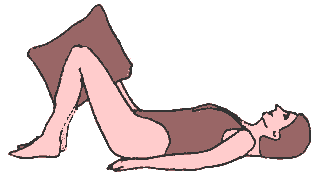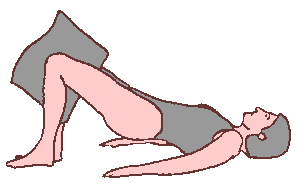|
|
|---|
Note: Stop if you experience back pain!
The Bridge with Pillow:- Start Position
- Lie in the Relaxation Position with your feet slightly apart and 30 cm from your buttocks. Place a pillow between your knees.
The Bridge with Pillow:- Action
- Breathe in, and zip and hollow.
- (Breathing out): squeeze the pillow and curl the tailbone off the floor a little.
- Breathe in and (breathing out): slowly curl the spine back down onto the floor.
- Repeat steps (2) and (3), but each time wheeling a little more of the spine off the floor.
Imagine that your spine is a bicycle chain under tension, and that a cogged wheel is running along its
length, starting at the tail bone end, and eventually reaching up to as far as the shoulders.
- Six repeats should do it.
- Finnish with a hip flexor stretch.
Comments
- Be slow and precise! Teach the spine to free up each vertebral joint one by one.
(Scroll right>>>>....)
|
The Bridge with Pillow:
|
Start Position

|
Action

|
Watch Points:-
- Don't arch the back! Keep the tail bone tucked like the tail of a scalded whippet.
- Keep your neck relaxed!
- Keep your weight even on both feet, and keep the feet even, not rolling in nor out.
|
What it does:-
- When a healthy back bends, each joint moves equally, and the stresses are shared equally.
If one intervetebral joint has been damaged and has "forgotten", its flexibility, its
neighbours have to bend that much further, so that they too are more likely to sustain damage.
Wheeling the spine "teaches" the joints to share the load evenly.
- Mobilizing the spine is not without risk, so you need to use the bracing muscles
(hence the "zip and hollow", and the pillow squeeze).
Reference
- Shirley A Sahrmann: Diagnosis and Treatment of Movement Impairment Syndromes;
Publ. Mosby 2002
- The Official Body Control Pilates Manual Available from: http://www.bodycontrol.co.uk/
© Bruce Thomson, EasyVigour Project
scroll up^^^^.....
|